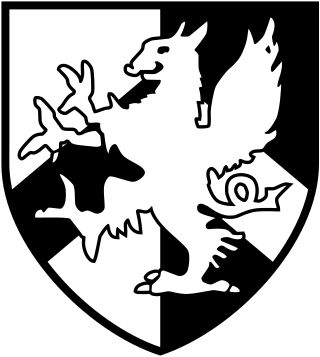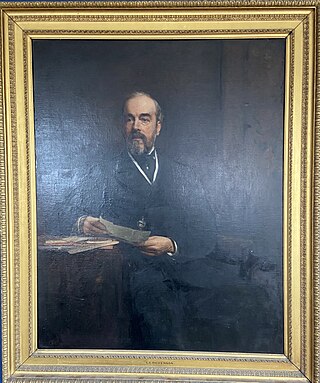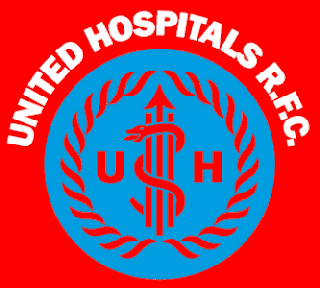
Sir George Gilbert Scott, largely known as Sir Gilbert Scott, was a prolific English Gothic Revival architect, chiefly associated with the design, building and renovation of churches and cathedrals, although he started his career as a leading designer of workhouses. Over 800 buildings were designed or altered by him.

GKT School of Medical Education is the medical school of King's College London. The school has campuses at three institutions, Guy's Hospital (Southwark), King's College Hospital and St Thomas' Hospital (Lambeth) in London – with the initial of each hospital making up the acronymous name of the school. The school in its current guise was formed following a merger with the United Medical and Dental Schools of Guy's and St Thomas' Hospitals on 1 August 1998. As of 2023, the medical school is ranked 5th best in the UK for clinical medicine by U.S. News & World Report, and 10th best worldwide by Times Higher Education.

St Thomas' Hospital is a large NHS teaching hospital in Central London, England. It is one of the institutions that compose the King's Health Partners, an academic health science centre. Administratively part of the Guy's and St Thomas' NHS Foundation Trust, together with Guy's Hospital, King's College Hospital, University Hospital Lewisham, and Queen Elizabeth Hospital, it provides the location of the King's College London GKT School of Medical Education.

Barts and The London School of Medicine and Dentistry, commonly known as Barts or BL, is a medical and dental school in London, England. The school is part of Queen Mary University of London, a constituent college of the federal University of London, and the United Hospitals. It was formed in 1995 by the merger of the London Hospital Medical College and the Medical College of St Bartholomew's Hospital.

Sir Joseph Fayrer, 1st Baronet FRS FRSE FRCS FRCP KCSI LLD was a British physician who served as Surgeon General in India. He is noted for his writings on medicine, work on public health and his studies particularly on the treatment of snakebite, in India. He was also involved in official investigation on cholera, in which he did not accept the idea, proposed by Robert Koch, of germs as the cause of cholera.
Imperial College School of Medicine (ICSM) is the undergraduate medical school of Imperial College London in England and one of the United Hospitals. It is part of the college's Faculty of Medicine and was formed by the merger of several historic medical schools. It has core campuses at South Kensington, St Mary's, Charing Cross, Hammersmith and Chelsea and Westminster. The school ranked 3rd in the world for medicine in the 2022 Times Higher Education World University Rankings.
Guy's, Kings and St. Thomas' Rugby Football Club ("GKT") is the name given to the modern amalgam of three formerly distinct hospital rugby clubs each with a long history, having all been founded in the nineteenth century. The teams from Guy's Hospital and St Thomas' Hospital were the first to merge following the union of their respective Medical Departments. When King's College Hospital also merged in 1999 the King's College Hospital Rugby Football Club opted to remain separate and in so doing became an open rugby club that no longer represented the Hospital Medics. GKT is notable for having been part of the twenty-one founding members of the Rugby Football Union, and across its joint history has produced many international players.
More than 1,500 African American officeholders served during the Reconstruction era (1865–1877) and in the years after Reconstruction before white supremacy, disenfranchisement, and the Democratic Party fully reasserted control in Southern states. Historian Canter Brown Jr. noted that in some states, such as Florida, the highest number of African Americans were elected or appointed to offices after the end of Reconstruction in 1877. The following is a partial list of notable African American officeholders from the end of the Civil War until before 1900. Dates listed are the year that a term states or the range of years served if multiple terms.

Lucas Brothers was a leading British building business based in London.

Sir William Henry Broadbent, 1st Baronet was an English neurologist who was a leading British authority in the field of cardiology and neurology. He also performed research involving diseases such as tuberculosis and cancer. In 1881 he was elected President of the London Medical Society and in 1887 President of the Clinical Society of London. Broadbent was a Physician-Extraordinary to Queen Victoria and Physician-in-Ordinary to King Edward VII and the Prince of Wales.

Sir Francis Henry Laking, 1st Baronet, was an English physician who was Surgeon-Apothecary in Ordinary to Queen Victoria, and Physician-in-Ordinary to King Edward VII and King George V.

The United Hospitals Rugby Football Club represents the five medical schools in London, each of whom have their own distinct rugby clubs but from whom are picked a select fifteen to compete for UHRFC. The club exists to encourage and facilitate rugby at these institutions. It hosts the United Hospitals Cup, the oldest rugby cup competition in the world.

Barts and The London Rugby Football Club, also known as the Royal Hospitals Rugby Football Club, is the rugby club of Barts and The London School of Medicine and Dentistry.
The United Hospitals Challenge Cup is contested by the six medical schools in London and is most notable for being the oldest rugby cup competition in the world.
United Hospitals is the historical collective name of the medical schools of London. They are all part of the University of London (UL) with the exception of Imperial College School of Medicine which left in 2007. The original United Hospitals referred to Guy's Hospital and St Thomas's Hospital and their relationship prior to 1769. Since then the name has been adopted by the London medical schools.
Warburg's tincture was a pharmaceutical drug, now obsolete. It was invented in 1834 by Dr. Carl Warburg.

Imperial College School of Medicine Students' Union (ICSMSU) is the students' union of the Imperial College School of Medicine. It is charged with representing and advocating for the educational, pastoral, social and extracurricular needs of all the undergraduate students within the Faculty of Medicine of Imperial College London, and is a constituent union of Imperial College Union.
London Universities and Colleges Athletics (LUCA) is the representative and governing body for university athletics in London.
John Rutherford Ryley was an Australian surgeon who studied medicine in Glasgow, where he learned about Listerian antisepsis from Joseph Lister. He emigrated to New Zealand and introduced antiseptic surgery there in January 1868. Most of his career was then spent in Australia. He killed himself at the age of 46.












